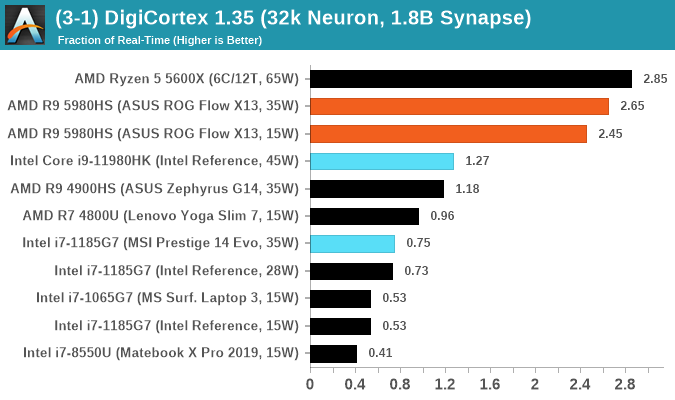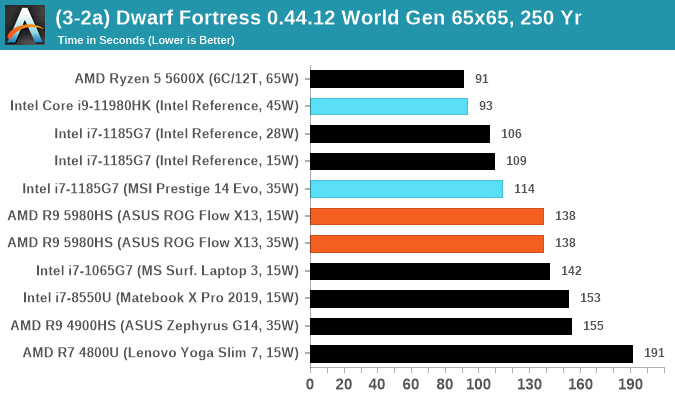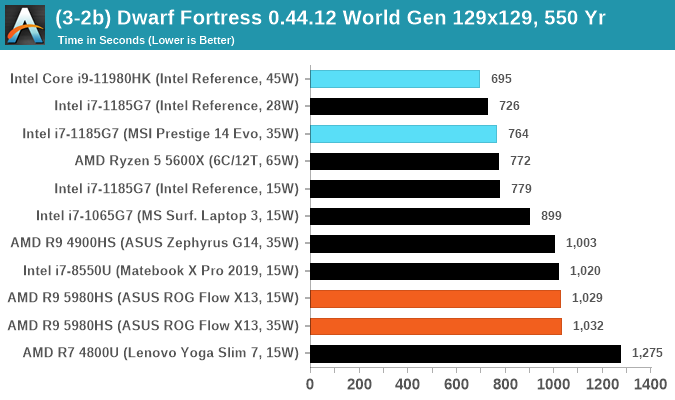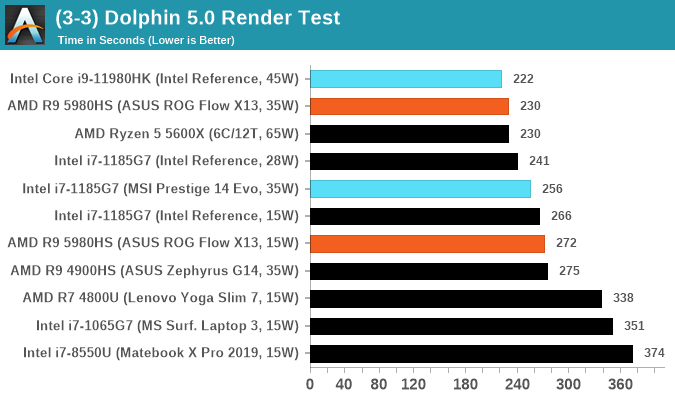Intel 11th Generation Core Tiger Lake-H Performance Review: Fast and Power Hungry
by Brett Howse & Andrei Frumusanu on May 17, 2021 9:00 AM EST- Posted in
- CPUs
- Intel
- 10nm
- Willow Cove
- SuperFin
- 11th Gen
- Tiger Lake-H
CPU Tests: Simulation
Simulation and Science have a lot of overlap in the benchmarking world, however for this distinction we’re separating into two segments mostly based on the utility of the resulting data. The benchmarks that fall under Science have a distinct use for the data they output – in our Simulation section, these act more like synthetics but at some level are still trying to simulate a given environment.
DigiCortex v1.35: link
DigiCortex is a pet project for the visualization of neuron and synapse activity in the brain. The software comes with a variety of benchmark modes, and we take the small benchmark which runs a 32k neuron/1.8B synapse simulation, similar to a small slug.
The results on the output are given as a fraction of whether the system can simulate in real-time, so anything above a value of one is suitable for real-time work. The benchmark offers a 'no firing synapse' mode, which in essence detects DRAM and bus speed, however we take the firing mode which adds CPU work with every firing.
The software originally shipped with a benchmark that recorded the first few cycles and output a result. So while fast multi-threaded processors this made the benchmark last less than a few seconds, slow dual-core processors could be running for almost an hour. There is also the issue of DigiCortex starting with a base neuron/synapse map in ‘off mode’, giving a high result in the first few cycles as none of the nodes are currently active. We found that the performance settles down into a steady state after a while (when the model is actively in use), so we asked the author to allow for a ‘warm-up’ phase and for the benchmark to be the average over a second sample time.
For our test, we give the benchmark 20000 cycles to warm up and then take the data over the next 10000 cycles seconds for the test – on a modern processor this takes 30 seconds and 150 seconds respectively. This is then repeated a minimum of 10 times, with the first three results rejected. Results are shown as a multiple of real-time calculation.

Dwarf Fortress 0.44.12: Link
Another long standing request for our benchmark suite has been Dwarf Fortress, a popular management/roguelike indie video game, first launched in 2006 and still being regularly updated today, aiming for a Steam launch sometime in the future.
Emulating the ASCII interfaces of old, this title is a rather complex beast, which can generate environments subject to millennia of rule, famous faces, peasants, and key historical figures and events. The further you get into the game, depending on the size of the world, the slower it becomes as it has to simulate more famous people, more world events, and the natural way that humanoid creatures take over an environment. Like some kind of virus.
For our test we’re using DFMark. DFMark is a benchmark built by vorsgren on the Bay12Forums that gives two different modes built on DFHack: world generation and embark. These tests can be configured, but range anywhere from 3 minutes to several hours. After analyzing the test, we ended up going for three different world generation sizes:
- Small, a 65x65 world with 250 years, 10 civilizations and 4 megabeasts
- Medium, a 127x127 world with 550 years, 10 civilizations and 4 megabeasts
- Large, a 257x257 world with 550 years, 40 civilizations and 10 megabeasts
DFMark outputs the time to run any given test, so this is what we use for the output. We loop the small test for as many times possible in 10 minutes, the medium test for as many times in 30 minutes, and the large test for as many times in an hour.


Dolphin v5.0 Emulation: Link
Many emulators are often bound by single thread CPU performance, and general reports tended to suggest that Haswell provided a significant boost to emulator performance. This benchmark runs a Wii program that ray traces a complex 3D scene inside the Dolphin Wii emulator. Performance on this benchmark is a good proxy of the speed of Dolphin CPU emulation, which is an intensive single core task using most aspects of a CPU. Results are given in seconds, where the Wii itself scores 1051 seconds.













229 Comments
View All Comments
Spunjji - Thursday, May 20, 2021 - link
He measured the power consumption, you pillock. It's right there in the review. Nice work getting your FUD on the front page though, round of applause for gondaft.If Tiger Lake H will be better in "the right chassis", Intel really should have thought of that when they supplied this one. As things stand, it's clear that this chassis wasn't causing the CPU to throttle at 45W, so the only way it would perform better is in a chassis that allows for 65W - at which point you'd find AMD's CPUs performing better, too...
5j3rul3 - Monday, May 17, 2021 - link
It's a big step to intelM1 and Ryzen 5000 are powerful, Intel need more pros to getting the leading performance
mode_13h - Monday, May 17, 2021 - link
This is definitely what Rocket Lake should've been. If they just put this chip in a desktop package, so it could be run with a desktop power budget and cooling, it'd sure be a lot more interesting than it is inside a laptop.Exotica - Monday, May 17, 2021 - link
Yields may have been the primary concern.mode_13h - Monday, May 17, 2021 - link
I get why they didn't do it, but it's clear to me this chip really wants to be a desktop CPU.whatthe123 - Monday, May 17, 2021 - link
it's probably more that they've tweaked their 10nm to hit high boost at the cost of efficiency. I think they increased their gate pitch with "superfin" so you end up with more performance scaling but also more power use. considering how far behind their desktop chips are compared to 7nm chips from AMD they may just be crippling efficiency across the board to get performance parity while their fabs lag behind. they don't seem to have high hopes for 10nm considering their target for market leadership is 2024 with 7nm.laptop users generally stick with bursty operations or video games and in both cases raw throughput isn't as much of a concern. average user would probably not notice or even benefit from the high ST burst performance, but anyone planning on using it professionally would probably be better off with cezanne.
Spunjji - Tuesday, May 18, 2021 - link
It would certainly be able to stretch its legs better there. It would be interesting to see whether it could handle running those higher boost clocks across more cores with a higher TDP. Guess we'll find out with Alder Lake.Lucky Stripes 99 - Monday, May 17, 2021 - link
I thought the same. This chip in a mini-STX case with a desktop cooler would make a great portable system. However, if it is having thermal issues with a full-size workstation laptop, it'll likely struggle in the smallest of SFF cases like the NUC.Azix - Monday, May 17, 2021 - link
the laptop doesn't look that that big. A nuc would have more vertical space for the cooling for example. It would also be easier to throw that heat out.mode_13h - Monday, May 17, 2021 - link
Uh, the mini-STX NUCs don't really have much space. Everything is packed in pretty tightly. Furthermore, they usually top out at 28 W.For Coffee Lake, Intel made a larger system they called a "NUC", but I think they had actual Nvidia graphics cards in them and were bigger than a lot of mini-PCs.